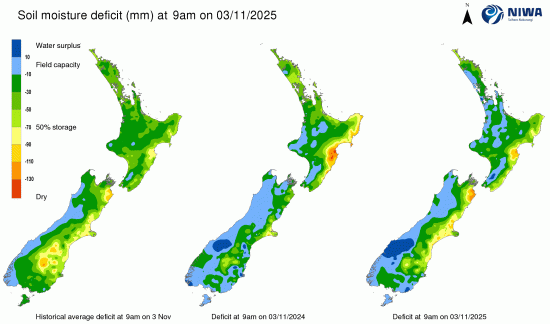
Here's our summary of key economic events overnight that affect New Zealand, with news the sheer scale of the US tariff taxes on the American consumer is starting to be revealed.
But first up today, all eyes have been on Fed boss Powell and his Jackson Hole speech. He noted the core US economy has weathered the "sweeping changes in [US] economic policy" well but now says "the balance of risks appears to be shifting" - to the negative side. Markets have taken this as a hint a rate cut could come as early as their mid September meeting.
The US equity markets roared back to post a record high. The USD fell. Benchmark bond yields retreated.
However, in the euphoria of the possibility of a rate cut markets seem to be ignoring this part: "inflation expectations could move up, dragging actual inflation with them. Inflation has been above our target for more than four years and remains a prominent concern for households and businesses". But they are betting on the 'transitory' inflation story again.
And the Congressional Budget Office has estimated the impact of the tariff taxes. It is clear now that almost all of these are going to be paid by Americans, first by the importer, then by consumers in higher prices. The CBO is suggesting that the substitution of imported goods for locally sourced goods will be low and not sustained. What will be sustained in the tax. They say those costs will rise "by US$3.3 trillion if the higher tariffs persist for the 2025‒2035 period". That will go some way to reducing future deficits, but over that decade it will only ameliorate them by -US$700 bln if nothing else changes. Given the annual Trump deficits are swelling to average -US$2.2 tln per year, this actually isn't much.
Equity markets are brave to think Powell's caveats in the inflation risks can be dismissed.
Across the border, Canadian retail sales in June were +6.5% higher than a year ago, the best rise since the pandemic recovery period in 2022. But some of this is just higher prices flowing through from their tariff dispute with the US, and a small correction dip is expected in the July data. And the Canadians are not ignoring the inflation risks of tariffs. To keep a lid on these inflationary effects of that dispute, Canada said it will roll back its retaliatory tariffs on the US. The US isn't doing the same, so their consumers will still pay the extra on imports.
Across the Pacific, China reported more ugly foreign direct investment data. While it didn't actually shrink like it did in April and June, it is running -13.4% below year ago levels, and it is still less than half the July ytd level;s of 2022 or 2023, and down -7.3% from last year. The June to July gain this year, while welcome, isn't anything more than a statistical blip in the context of the fall away over the last four years.
So it is no surprise that Beijing is reorienting to a focus on internal consumption - something they have a chance of still controlling. The international trade environment isn't moving in their favour and even where they do still get gains, they are not enough to move their needle.
There was a surprising dip in Japanese inflation in July. It eased to 3.1% from 3.3% in the previous month, the lowest reading since November 2024. Helping was that electricity prices fell for the first time since April 2024. But food prices jumped +7.6%, the most since February. Again, rice was the big culprit.
New data out from the Australian statistics bureau shows their R&D investment grew by +18% to AU$24 bln in 2023-24. The strongest growth was in IT including spending on Artificial Intelligence, which grew by +142% since 2021-2022.
The UST 10yr yield is now at 4.26%, down -7 bps from yesterday at this time, down -6 bps for the week. The key 2-10 yield curve is now steeper at +57 bps. Their 1-5 curve is more inverted, now by -13 bps. And their 3 mth-10yr curve is now inverted -9 bps. The Australian 10 year bond yield starts today at 4.31% and down -1 bp from yesterday but up +4 bps for the week. The China 10 year bond rate is up +1 bp at 1.78%, up +4 bps for the week. The NZ Government 10 year bond rate starts today at just under 4.42% and up +3 bps, down -3 bps for the week.
Wall Street has roared back in Friday trade with the S&P500 up +1.5% after the Powell hint of a rate cut next month. That means it is able to claim a +0.4% advance for the week which pushed it to a new record high. Overnight, European markets were firner between London's small +0.1% gain and Paris's +0.4% gain. Tokyo ended its Friday session up +0.1% to be down -2.0% for the week. Hong Kong was up +0.9% on Friday for a weekly rise of +0.2% while Shanghai was up +1.4% to be +3.1% higher for its week. Singapore was up +0.5% on Friday. The ASX200 fell -0.6% for a weekly +0.3% gain, while the NZX50 fell -1.1% on Friday trade to limit its week to a gain of +1.2%.
The Fear & Greed index his still in the 'greed' zone same as it was last week.
The price of gold will start today at US$3,371/oz, up +US$34 from yesterday, up +US$37 for the week. Silver soared to US$39/oz, approaching the 14-year high of $39.50 it touched in the end of July
American oil prices have risen +50 USc to just under US$64/bbl with the international Brent price now just under US$68/bbl. These levels are more than +US$1 higher than a week ago
The Kiwi dollar is at just on 58.7 USc and up +½ from yesterday but down -½ from last week at this time. Against the Aussie we have dipped -20 bps at 90.4 AUc. Against the euro we are unchanged at 50.1 euro cents. That all means our TWI-5 starts today at just under 66.3, little-changed from yesterday but down -60 bps for the week.
The bitcoin price starts today at US$116,875 and up +3.8% from this time yesterday. But it is down -0.5% from a week ago. Volatility over the past 24 hours has been moderate at just under +/-2.4%.
Daily exchange rates
Select chart tabs
The easiest place to stay up with event risk is by following our Economic Calendar here ».
4 Comments
Suggest it would not need a sharp mind for a NZ business news reporter to think to canvass generally, the NZ exporters, meat, dairy, viticulture, horticulture and more, just to establish whether or not they have had to decrease their CIF prices to compensate for the tariff, and if so by how much.
Markets have taken this as a hint a rate cut could come as early as their mid September meeting.
Powell caved. In reality, the FOMC members should be hiking rates
At least Powell admitted that the U.S. economy is weaker and inflation stronger this year under Trump than last year under Biden.
If you're not prepared for stagflation in the U.S. and across the Anglosphere in particular, you're getting the wrong advice. I suspect most people have no exposure to gold or silver, even in their Kiwisaver.
Looks like Apple has given up on AI. The company is currently in early discussions with Google about using Google’s Gemini artificial intelligence to power a completely revamped version of Siri, expected to launch in 2026. This move reflects Apple’s urgency to close its significant gap in generative AI capabilities compared to rivals like Google, Samsung, Microsoft, and Amazon, all of whom have made substantial advances in their own conversational AI voice assistants.
https://finance.yahoo.com/news/apple-explores-using-google-gemini-17183…
Nailbiter, who's game to make a half time bet... ITGUY, Averageman?
its much like the NZ property market
UPDATE: the Argies lead, who will take the full time whistle



We welcome your comments below. If you are not already registered, please register to comment.
Remember we welcome robust, respectful and insightful debate. We don't welcome abusive or defamatory comments and will de-register those repeatedly making such comments. Our current comment policy is here.